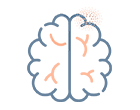근긴장 이상(Dystonia) 정밀 패널
근긴장 이상은 비정상적이고 종종 반복적인 움직임, 자세 또는 이 둘 모두를 유발하는 지속적 혹은 간헐적인 근육 수축이 특징인 이질적인 운동 장애입니다. 근긴장이상운동은 일반적으로 패턴이 있고 뒤틀리고 심지어 떨리는 증상도 있습니다.

Skogseid I. M. (2014). Dystonia–new advances in classification, genetics, pathophysiology and treatment. Acta neurologica Scandinavica. Supplementum, (198), 13–19. https://doi.org/10.1111/ane.12231
Lohmann, K., & Klein, C. (2017). Update on the Genetics of Dystonia. Current neurology and neuroscience reports, 17(3), 26. https://doi.org/10.1007/s11910-017-0735-0
Steeves, T., Day, L., Dykeman, J., Jette, N., & Pringsheim, T. (2021). The prevalence of primary dystonia: A systematic review and meta-analysis. Retrieved 31 March 2021
Vidailhet, M., Méneret, A., & Roze, E. (2020). Dystonia: genetics, phenomenology, and pathophysiology. The Lancet. Neurology, 19(11), 881–882. https://doi.org/10.1016/S1474-4422(20)30366-5
Balint, B., Mencacci, N. E., Valente, E. M., Pisani, A., Rothwell, J., Jankovic, J., Vidailhet, M., & Bhatia, K. P. (2018). Dystonia. Nature reviews. Disease primers, 4(1), 25. https://doi.org/10.1038/s41572-018-0023-6
Albanese, A., Barnes, M., Bhatia, K., Fernandez-Alvarez, E., Filippini, G., & Gasser, T. et al. (2006). A systematic review on the diagnosis and treatment of primary (idiopathic) dystonia and dystonia plus syndromes: report of an EFNS/MDS-ES Task Force. European Journal Of Neurology, 13(5), 433-444. doi: 10.1111/j.1468-1331.2006.01537.x
Schwarz, C. S., & Bressman, S. B. (2009). Genetics and treatment of dystonia. Neurologic clinics, 27(3), 697–vi. https://doi.org/10.1016/j.ncl.2009.04.010